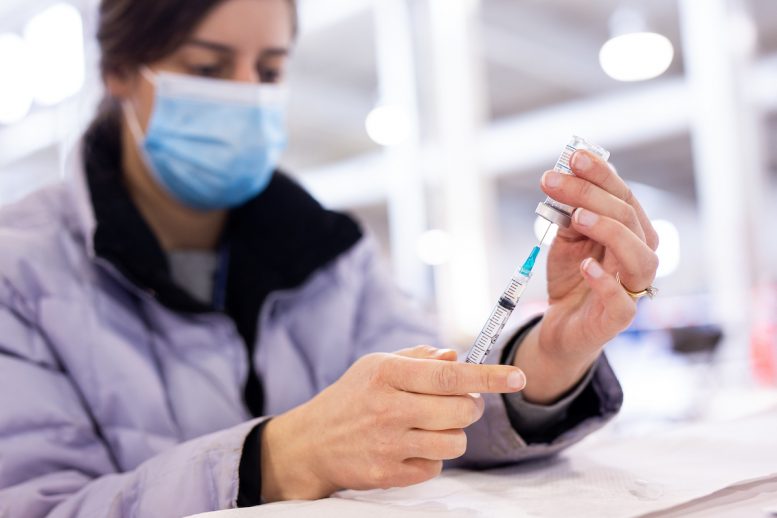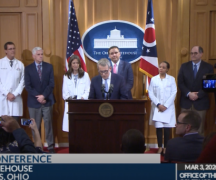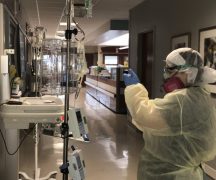After months of increasing vaccination rates and declining coronavirus cases, infections are again going up in Ohio.
Gov. Mike Dewine and health officials on Thursday said the increase has put the state in a race against more-contagious variants that evolve from the “mutant swarm” that thrives so long as the virus has plenty of hosts to infect. However, limiting the number of hosts by getting Ohioans immunized might be hitting a ceiling.
Despite more than a third of Ohioans receiving at least a first dose of the coronavirus vaccine, the 2,742 new cases in the state on Thursday was more than double the 21-day average. Bruce Vanderhoff, the Ohio Department of Health’s chief medical officer, said the increase appears to be due to the B.1.1.7 variant, which he said is “not only more contagious, it’s also more deadly.”
Ohio’s neighbor to the north, Michigan, is seeing the sharpest increase in new cases in the United States and 70% of them appear to be from the B.1.1.7 variant.
Now the variant seems to be becoming predominant in Ohio as well.
Researchers detected 92 cases of the B.1.1.7 variant on March 12. They detected 797 on Thursday. That means it’s doubling every nine or 10 days, Vanderhoff said.
“Ohio remains in a very important race against time with the virus and its variants,” he said. “In the next couple of weeks, the variant will be the virus that we’re dealing with.”
Yet many Ohioans might not be interested in taking up the baton in that race.
All Ohioans 16 and over are now eligible for the vaccine. Even so, DeWine on Thursday said that some county health departments this week told state officials not to send any more doses because they’ve haven’t been able to use the supplies they already had.
Also, those most vulnerable to coronavirus — Ohioans 65 and older — have been eligible for the vaccine for months. But less than 75% of them have received at least one dose of the vaccine.
Part of the reason some elderly residents haven’t been vaccinated is because it’s difficult for them to get to vaccination sites. DeWine said county health departments “are working mightily” to help those people.
But millions of Ohioans of all ages remain unvaccinated.
“I think that it’s a combination of a lot of different things and I think it’s a process,” DeWine said when asked why so many haven’t gotten shots. “We have to keep working hard and making it as easy for people as possible.”
To help do that, state health officials are working with private businesses, churches and labor unions to set up vaccine clinics so people can get the shot at places they’re already going to. Also, DeWine said the state will expand clinics where people can walk in and get a shot without an appointment.
But part of the hesitancy has to do with political ideology. Former President Donald Trump spent months downplaying the pandemic, promoting fake cures and mocking mask-wearing as well as other precautions. It seems to have had an effect.
A recent NPR/Marist poll found that 50% percent of Republican men and 47% of Trump supporters don’t plan to be vaccinated. Altogether, the poll found, 30% percent of Americans don’t plan to get the vaccine, putting in jeopardythe goal of achieving herd immunity so the virus can’t keep evolving into scarier and scarier versions of itself.
DeWine said he had seen such polling.
“Part of this is persuasion,” he said. “It just seems that the most common persuader is your family. Your close friends. What you see them doing. I would just constantly continue to urge, if you have a loved one in your family who has not been vaccinated, whatever their age, please try to persuade them to do it.”
***
Also from Ohio Capital Journal:
An estimated 37,000 American kids lost a parent to COVID-19, study finds
An estimated 37,000 to 43,000 American children lost a parent to COVID-19 as of February, according to research published this week.
Among the findings, which appeared in JAMA Pediatrics, children aged 0 to 17 experienced a surge in what’s known as “parental bereavement” of somewhere between 17.5% and 20.2%.
Of those 37,000 who lost a parent, an estimated 73% of them are aged 10-17.
The lower estimate is based on a calculation using official data on the number of deaths that health departments have attributed to COVID-19.
The higher estimate is based on the estimated number of “excess deaths,” or number of deaths beyond what could be expected in a non-pandemic year. Epidemiologists use excess deaths to measure pandemics because they capture changes in death rates on a large scale, providing a clearer picture of a pandemic’s damage. READ MORE
Supreme Court to hear case of woman charged with possession after newborn tests positive
The Ohio Supreme Court is taking up a case in which a woman was convicted of drug possession, but the only drugs she possessed were in her blood system and the blood system of her newborn.
Kelly Foreman was charged in Seneca County on felony drug possession charges “despite the fact that she was never shown to be in actual or constructive control of any drugs in Seneca County,” attorneys for Foreman said in appealing her conviction.
The case began after Foreman gave birth in March 2018. A test was conducted after the infant “exhibited symptoms of neonatal-abstinence syndrome” and the baby’s urine and umbilical cord tissue showed the presence of cocaine, court documents stated.
Foreman admitted to an investigating caseworker that she had used cocaine while pregnant, but the last time had been nearly two weeks before the birth. She denied using drugs at her home in Seneca County.
A Seneca County grand jury indicted Foreman on one fifth-degree felony count of possession of cocaine, and she was convicted and sentenced to three years of community control. READ MORE





